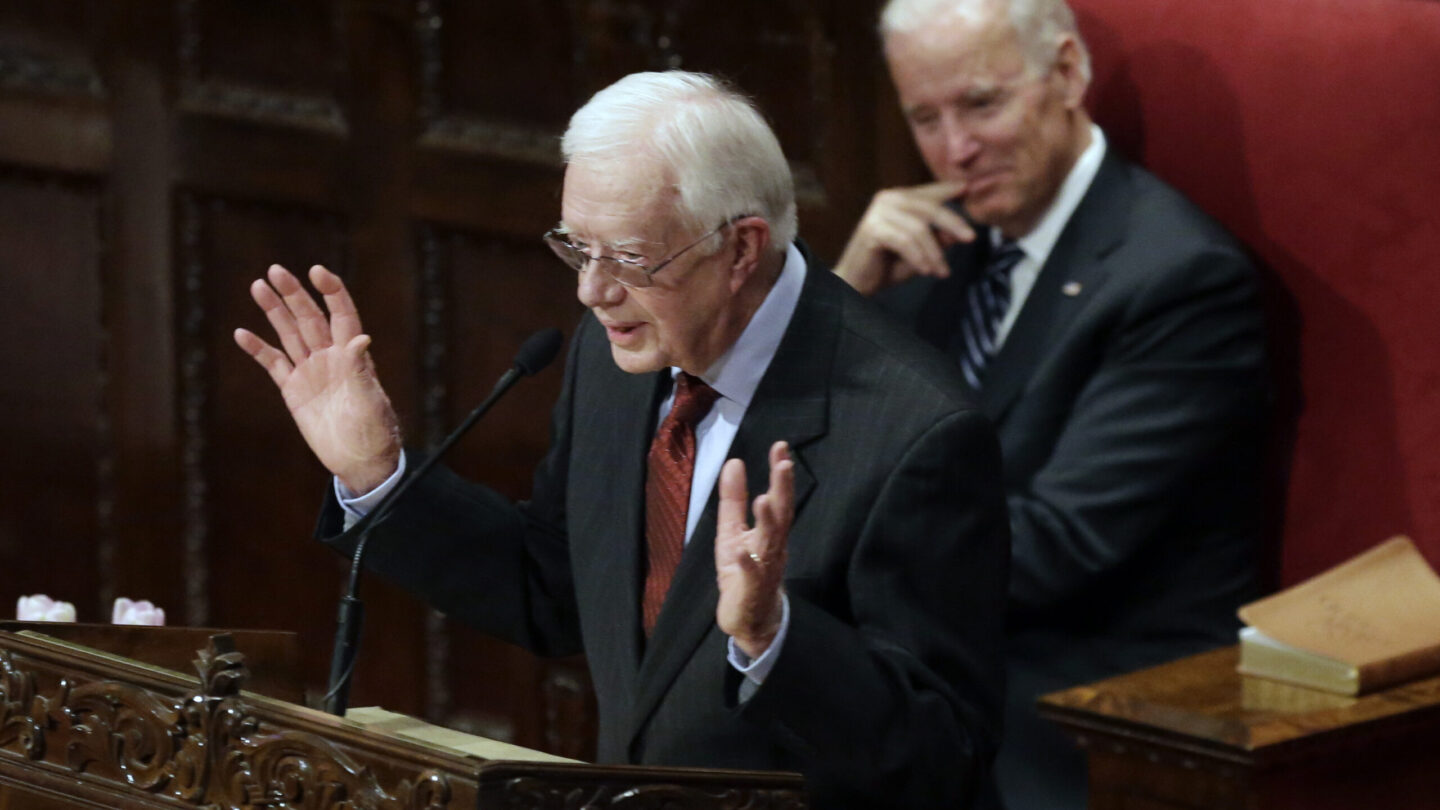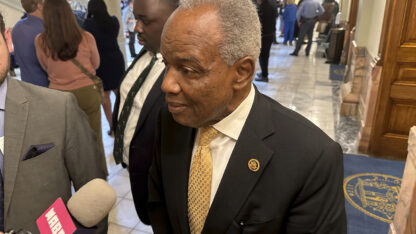President Biden, like any second-year occupant in the Oval Office, does not much like the phrase “one-term president.”
As a Democrat, he presumably does not enjoy the comparison some are making between him and Jimmy Carter, the only Democratic president since the 1800s that the voters sent packing after just four years.
But that comparison is, as they say, out there. And as the White House ponders staff moves in the months ahead, it knows it needs to address the dread “Carter model.”
To be fair, Carter’s ill-fated presidency occurred during extraordinarily difficult times, beset by numerous global crises and dogged by economic conditions he largely inherited from his predecessor. Biden’s defenders might say the same.
We should also note that Carter, at 97, is the longest living president ever and has long since rewritten his legacy with decades of humanitarian work at home and abroad. Overwhelming majorities of Americans approve of his performance since leaving office and polls show the public’s assessment of his years in office has risen as well. Presidential scholars generally rate him in the middle ranks of U.S. presidents.
Yet Carter remains a punchline in American politics, scarcely acknowledged at his party’s national political conventions and rarely listened to in policy debates. That is because when he left office four decades ago, Carter was down to 34% approval in the Gallup Poll and lost to Ronald Reagan in 1980 by a landslide in the Electoral College.
Not just another election, 1980 signaled a sea change in American politics. A half century of the New Deal and Democratic domination gave way to an era in which Republicans more than held their own, winning the Electoral College in six of the next 11 cycles and controlling at least one chamber of Congress two-thirds of the time.
Carter also left a legacy of frustration and fecklessness that has been difficult for Democrats to shake. He is remembered for the Iran hostage crisis that consumed the last year of his presidency. He is remembered for his hapless struggles against inflation, high gas prices and the threat of oncoming recession — not to mention an aggressive Russian war machine invading a neighboring country in defiance of the world community.
Not-so-faint memories
It is hard to miss the parallels between Carter’s predicaments four decades ago and Biden’s today, or the similarities in their performances. Gas prices are at historic highs again. Inflation is back up to high single digits (8.8% for the 12 months ending in May) and threatening to go higher. Recession threats are in the air as well.
As Carter had to deal with Russia in Afghanistan, Biden has to confront its invasion of Ukraine. Carter’s embargo on Russian grain and boycott of the 1980 Moscow Olympics contributed to his popularity’s decline.
Both Carter and Biden also came to office when social change was upsetting many American communities. Movements for civil rights and women’s rights had met rising levels of pushback from opponents, galvanized in some cases by the rulings of federal courts and the Supreme Court in particular.
Carter was personally opposed to abortion but supported the Court’s 1973 Roe v. Wade ruling. The resistance to Roe was gathering steam at the time among conservatives and not a few Democrats. Nearly half a century later, the shoe is on the other foot and the overturning of Roe by the current court’s majority in Dobbs v. Jackson is yet another wedge dividing the national community.
There were other sources of unease in the body politic in Carter’s era that have their analogs today. For not a few families and community leaders who remember the 1970s, the current threats of crime, drugs, racial unrest and distrust of authority are all too familiar.
And the similarities in circumstances carry over to comparisons of leadership. Carter was remembered for his “malaise” speech, which did not contain the word “malaise” and which was widely misinterpreted as blaming American citizens for the ills that had caused, or been caused by, their own sour mood.
Biden has been faulted for speeches that do not seem to meet the moment and lack the urgency that might compel others to follow. His soothing approach to issues that prompt anger has often failed to soothe.
The coin of the realm in assessing presidents has long been the running tally of public approval kept by the Gallup Organization. Both Carter and Biden saw their approval fall to around 40% after 18 months in office.
Zbigniew Brzezinski, Carter’s national security adviser, wrote in 1983 that Carter “did not fire enthusiasm in the public or inspire fear in his adversaries. He was trusted, but that trust was — very unfairly — in him as a person but not in him as a leader. He had ambitious goals for the nation…and yet he did not succeed in being seen as a visionary or in captivating the nation’s imagination.”
Something similar might be said of Biden today.
Different paths to frustration
Carter and Biden’s paths to the White House could scarcely have been more different. Carter did not seem a likely candidate for the nomination when he began his lonely quest for it in 1973 after serving a single term as governor of Georgia. But he worked the Iowa caucuses and the New Hampshire farmers and eventually put together a string of primary victories that gave him the nomination.
Carter appealed to an electorate weary of Vietnam and the scandal era known as Watergate. Although Richard Nixon was already out of office, Carter won largely by contrasting himself with the last elected president (much as Biden would do in 2020).
Carter’s electoral superpower was that as a Georgia peanut farmer and a Baptist Sunday School teacher he was able to carry the South. But that magic did not help him in office. Historian Douglas Brinkley has observed that “the soft-drawling, broad-grinning Carter took pride in his ignorance of Washington’s ways.”
He tried to pass major bills without clearing them with the Democratic speaker of the House, Thomas P. “Tip” O’Neill, and enraged Western senators with a “hit list” of water projects he thought were unnecessary. Liberals who fell in line for Carter in 1976 fell out of love quickly, prompting a challenge from the left to Carter’s re-nomination.
But Biden, too, despite his far greater familiarity, had trouble bending Congress to his will in his first year. Democrats had only a slim margin of majority in the House and a 50-50 tie in the Senate broken by Vice President Kamala Harris. It was enough for some COVID relief bills and stimulus spending and a modest gun control bill. But it has not been enough for the bulk of Biden’s program, or to ban assault weapons or to restore abortion rights or voting rights recently curtailed by Supreme Court decisions.
Scant control
Quite apart from their struggles with Congress, both Carter and Biden found themselves preoccupied by issues over which they had scant control. Carter took office with the country still reeling from the 1973 Arab oil embargo that had blown up the price of energy and spurred overall inflation.
At the same time, Carter took the oath when the country was recovering from a lingering recession from the mid-1970s. Those conditions had prompted the Federal Reserve to lower rates, which had also fueled inflation. When the Fed raised rates again, the recovery economy faltered.
Growth, confidence and job creation declined. Carter responded with a public works bill that seemed popular, but then OPEC decided to double the price of its crude oil exports again, driving inflation well into double-digits for the next several years — and quite possibly dooming his reelection.
Biden has been whipsawed by a similar dynamic involving oil prices and the Fed, with the added complication of COVID’s effects on the economy and on government spending. Just when Biden’s policymakers had hoped post-COVID recovery inflation would start to ease, the Russian invasion of Ukraine and retaliatory measures caused the worldwide price of oil to leap well above $100/barrel, juicing inflation worldwide, forcing a reversal of Fed policy and threatening the U.S. with recession.
Carter and Biden might also have compared their plights on the issue of refugee admissions. Carter was presented with thousands of overnight refugees from Cuba when the Castro regime there put them on the sea in the “Mariel boatlift.” Many were sent to Army bases around the country, disrupting those communities while the refugees were processed for resettlement.
Similar reactions are now familiar to Americans as far larger numbers of refugees from Central and South America have been dammed up along the U.S. Mexican border for months awaiting entry. The Supreme Court has agreed with the Biden administration that these would-be immigrants must be processed and, at least to some extent, admitted into the U.S.
Is the die cast?
It must be noted that an incumbent’s standing in the midst of a first term is far from a perfect predictor of reelection or rejection.
Barack Obama looked dead in the water after his party lost 62 seats in the House in 2010. Bill Clinton was also a wounded incumbent, losing his Democratic majorities in both chambers of Congress in his first midterm in 1994.
Even Reagan had a rocky first midterm in 1982 and sank in the polls, prompting speculation that he might not run for a second term. He did, though, and carried 49 states.
But we do know the standing of a president matters to midterm elections, which are now less than four months away — with voting beginning sooner in some states.
Biden will be judged on Democrats’ performance in those elections and thereafter by how he plays the cards he is dealt by those outcomes. This winter, candidates will begin declaring their candidacies against him in the Republican Party – and possibly in the Democratic Party, as well.
The atmosphere over the Biden presidency remains cloudy. But parts of the economic picture are brighter than they have been in several years, notably job growth and historically low unemployment. The Fed has a chance to dampen inflation without a full-scale recession. Gas prices could moderate somewhat.
Moreover, some of the hostility to former President Trump that lifted Biden into office may still be available as the Jan. 6 investigation continues to highlight the former president’s efforts to say in office after he lost.
So while Biden’s polls are down and his energy level seems low, there is time. He has time to turn it around. He has time to make things worse.
Carter did some of both. He had his triumph with the 1978 Camp David Accords, bringing peace between Israel and Egypt. He also had his worst crisis when 52 Americans were taken hostage in the U.S. Embassy in Iran, a protest against Carter for admitting the former ruler of Iran to the U.S. for medical treatment.
Robert Strong, a professor of politics at Washington and Lee University in Virginia has written that “there was always, it seemed, something unlucky about him: massive public disaffection with government, the fires of crisis breaking out at home and abroad, the hostile post-Watergate press, and by the end of his term, a challenge by a smooth, consummately telegenic challenger with an engaging new conservative message.”
The parallels here to Biden are, once again, are hard to miss. Except that in Biden’s case, the smooth and telegenic challenger was there before he took office and has never left the public eye. Strong was writing about the emergence of Reagan in 1980, but he might as well have been describing the hangover of Trump in 2022.
There is no one in the Democratic Party today to play the role played in 1980 by Sen. Edward M. Kennedy, the liberal champion who split the party by seeking its nomination against its incumbent. But Biden, who was already in the Senate when Carter was president, will be 80 later this year. He insists he plans to run again in 2024, but he may not. In that event, the one-term fate that was Carter’s would be fait accompli.
Copyright 2022 NPR. To see more, visit https://www.npr.org.9(MDAxODM0MDY4MDEyMTY4NDA3MzI3YjkzMw004))

9(MDAxODM0MDY4MDEyMTY4NDA3MzI3YjkzMw004))








